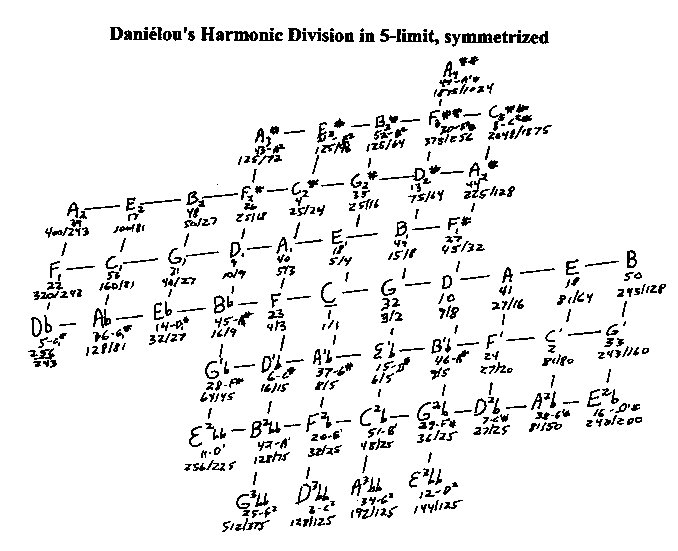Next Page: 5 – Four 53-eq Realms
Daniélou’s Harmonic Division in 5-limit
The division of the octave into 53 intervals is in conformity with the nature of sounds… Any other intervals would not bring out a distinct expressive quality, and would in any case be less consonant. Their use is therefore without interest. – Alain Danielou, Music and the Power of Sound, 1943
In the mid-20th century, Alain Danielou advocated for 53-equal tuning in his book Music and the Power of Sound. His book appears to me to be riddled with poor explanations and even mathematical mistakes, which made the exploration of his musical system almost impossible. Still, there was much interesting information, including a system of describing a harmonic relationship for all 53 notes. These are the 53 ratios Danielou chose to have represented in 53-equal temperament. None of these harmonic relationships go past the fifth harmonic, which is consistent with the fact that the ancients only very rarely explored seventh-harmonic relationships. I would suggest that two enharmonic (skhismic comma) notes be added to this because they are of real practical value for composers. The Db and Ab on this lattice are useful for Pythagorean scales, but those notes can also be useful when expressed as C1# (the leading tone of D, ratio 135/128) and G1# (the leading tone of A, ratio 405/256), Both of these would appear to the right of the F1# one row above the Middle C line. The rest of this chapter “translates” the Just Intonation/53 system of Danielou into my system of notation and explanations.
DANIELOU’S 5-LIMIT LATTICE OF 53 HARMONIC RELATIONSHIPS TO C
If you would like to learn more about this chapter, “Daniélou’s Harmonic Division in 5-limit,” you can buy the entire book, The Grand Unified Theory of Music, in pdf form for $25 with hundreds of embedded musical examples of scales and chords from all over the world.
A free introduction to what The Grand Unified Theory of Music offers is on this website and includes both text and a few musical examples from each webpage. If you would like to learn more about this chapter and the full contents of this entire e-book, you can buy The Grand Unified Theory of Music for $25, with hundreds of embedded musical examples of scales and chords from all over the world — and ideas for how to set up your computer system —
HERE.
You’ll get a personalized password you can use to see the entire e-book. Inside the full book, you will also get a link to the complete pdf file of this e-book, which you can read on your Kindle or similar device. The links to the hundreds of mp3 sound files – the same ones you can hear on the website — will also be included. This is “Version 1.0” of The Grand Unified Theory of Music. Because it is an e-book, additions, corrections and improvements in the sound may be added at any time. The Grand Unified Theory of Music is Copyright © 2018 by Christopher Mohr. All rights reserved.
One person per password. Sharing this password with others is a violation of copyright. Do not allow others to use your password or link to the pdf file!

